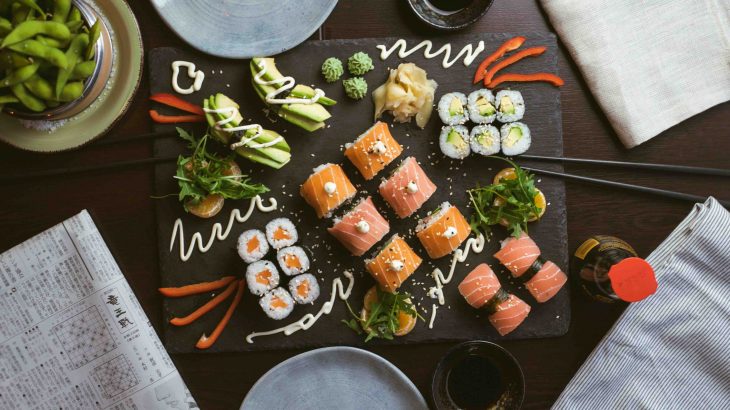
Dive into the world of sushi with us as we explore 20 sushi facts that are as vibrant and varied as the beloved dish itself. From its ancient origins to contemporary innovations, these facts will pique the curiosity of sushi connoisseurs and novices alike.
Ancient Origins
Despite its strong association with Japanese cuisine, sushi can trace its roots back to Southeast Asia around the 2nd century AD, when it began as a method of preserving fish in fermented rice.
Evolving Cuisine
Sushi, as we know it today, took shape during the Edo period in Japan (1603–1868), with the advent of ‘nigiri sushi. This variety features a slice of raw fish over vinegared rice and became the basis for modern sushi.
Sushi vs Sashimi
Although often grouped together, sushi and sashimi are different. While both can include raw fish, sushi refers to any dish that includes vinegared rice, while sashimi refers to thinly sliced raw fish or seafood served alone.

A Bite-sized Delight
Traditional sushi is designed to be eaten in one bite. This practice ensures that the balance of flavors and textures is experienced as the sushi chef intended.
Art of the Sushi Chef
Sushi chefs, or ‘itamae’, spend years honing their craft. Apprenticeships can last up to a decade, with several years spent just learning to prepare the rice.
Global Influence
Sushi reached the United States in the early 20th century, with the first sushi bar opening in Los Angeles in the 1960s. Today, sushi can be found all around the globe, often with regional variations.
Seasonal Sushi
Like many Japanese dishes, sushi ingredients often change with the seasons, reflecting the belief in eating what is fresh and available at each time of year.
Bluefin Tuna – A Sushi Star
Bluefin tuna, or ‘hon-maguro’, is highly prized in sushi cuisine, particularly the fatty belly part known as ‘otoro. However, concerns about overfishing have led some chefs to seek out sustainable alternatives.
The California Roll
One of the most popular types of sushi in the United States, the California roll, is an example of Western influence on the dish. It was created in Los Angeles and features avocado, crab meat, and cucumber.

Fresh Wasabi
Wasabi served in many sushi restaurants is often a mixture of horseradish, mustard, and green food coloring. Fresh wasabi is quite rare and expensive due to the difficulty of growing the plant.
Etiquette of Soy Sauce
Sushi etiquette suggests not over-soaking your sushi in soy sauce. The rice can absorb too much sauce, overpowering the delicate flavors of the fish and rice.
Rice Matters
Contrary to what some may believe, sushi does not mean ‘raw fish’. It refers to the vinegared rice that accompanies the fish or other toppings. In fact, the word sushi translates to ‘sour-tasting’.
Sushi for Dessert
In Japan, sushi can be enjoyed as a snack or a meal, and even, occasionally, as a sweet treat. Some chefs create sushi with fruit or other sweet ingredients, but it’s less common than savory varieties.
Nutritional Benefits
Sushi can be a healthy choice, depending on the ingredients. Raw fish is high in protein and omega-3 fatty acids, while the accompanying vegetables provide fiber and various vitamins and minerals.
Sushi Conveyor Belts
In 1958, the first conveyor belt sushi restaurant, or ‘kaiten sushi’, opened in Osaka, Japan. This innovation made sushi more accessible and affordable for everyone.
Vegetarian and Vegan Sushi
Sushi isn’t just for seafood lovers. Many sushi restaurants offer vegetarian and vegan options, featuring ingredients like avocado, cucumber, pickled vegetables, and even tofu.
Costly Delicacy
While sushi can be enjoyed on a budget, it can also be incredibly pricey. The world’s most expensive sushi, created by chef Angelito Araneta Jr., is wrapped in gold leaf and garnished with diamonds and pearls.

Sushi Knives
A sushi chef’s knives are of utmost importance. Some sushi knives are crafted from the same steel used to make samurai swords and require diligent care and maintenance.
Sushi Breakfast
At Tokyo’s famous fish market, Tsukiji, it’s not uncommon to have sushi for breakfast. A sushi breakfast is a delicious way to enjoy the freshest catch of the day.
Sushi Robots
As technology advances, sushi hasn’t been left behind. There are sushi-making robots that can produce up to 300 pieces of sushi in an hour!
Final Word
Embrace the art, tradition, and innovation that make sushi a globally loved dish. Whether you’re a sushi enthusiast or a newcomer to this culinary delight, there’s always more to learn, taste, and explore.
Was this page helpful?
Our commitment to delivering trustworthy and engaging content is at the heart of what we do. Each fact on our site is contributed by real users like you, bringing a wealth of diverse insights and information. To ensure the highest standards of accuracy and reliability, our dedicated editors meticulously review each submission. This process guarantees that the facts we share are not only fascinating but also credible. Trust in our commitment to quality and authenticity as you explore and learn with us.


